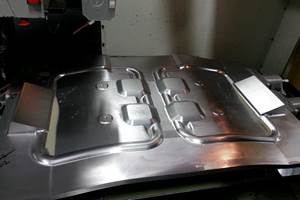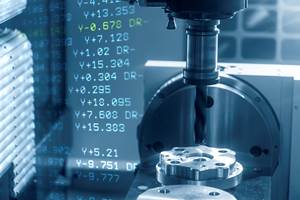Why Machine Tool Probes Are Becoming More Popular
Probing technology has come a long way in the last five years. Today's probing systems are highly accurate, very fast, and almost fail-safe.
Share





Probing technology has come a long way in the last five years. Today's probing systems are highly accurate, very fast, and almost fail-safe. While probe manufacturers have always done their part to be at the cutting edge of probing technology, the most important recent improvements have come from the machine tool builders and control manufacturers.
Accuracy is always of primary concern to probe users. Probe manufacturers claim (and have for a long time) that their probes will trigger within 20 millionths of an inch of deflection. While this is very good, probe triggering is just the first step to a probe cycle. After triggering, the CNC must attain the machine's position, which even today's best CNCs cannot do instantaneously. The lag time that passes between probe triggering and machine position attainment causes overshoot. While overshoot can be compensated for through calibration, the more the overshoot, the more potential there will be for variation in measurements.
Machine tools with analog drives will average about ten milliseconds of lag time. In ten milliseconds, a machine traveling at a feed rate of 30 ipm will move about 0.005 inch.
Many current controls boast digital drives, which provide much shorter lag times. One popular control manufacturer claims that their lag time is only 2 microseconds! At 1,000 ipm (much too fast for today's probes), the machine cannot even move 0.0001 inch in 2 microseconds. For all intents and purposes, controls with such capabilities have all but eliminated the lag time problem. It is almost as if the control can take a snapshot of the machine's position the instant the probe triggers.
This improved probing accuracy makes applications feasible that may not have been in the past. However, from the probe users we talk to, it still seems to be difficult to get machine tool builders and probe manufacturers to state and guarantee probing accuracy. Probing applications like in-process gaging demand accuracy. Generally speaking, your gaging device accuracy should be within ten percent of the tolerance you expect the device to hold. If trying to hold a 0.002-inch tolerance, for example, your probing system must have an accuracy of at least 0.0002 inch, which is right on the borderline of the best accuracy claims we have heard.
Another benefit of reduced lag time is that probing can be done much faster. For machines with lag times under 200 microseconds, at least one probe manufacturer no longer recommends the traditional two-touch probing cycle. Instead, they recommend touching each surface only once, and at a much faster feed rate than that for older probing systems. Instead of taking four to eight seconds per touch, these systems boast probing times of less than two seconds per touch.
Many systems also have excellent protection systems to avoid probe stylus and mechanism damage. Most will automatically halt motion if the stylus is deflected more than its normal amount. The best systems will do this even if the probe has not been activated. These protection systems make probes easier to use and minimize operator fear during operation. Keep in mind, however, that most systems are based upon probe stylus deflection. No system we know of can protect against probe shank collisions.
As time goes on, probing technology will continue to improve. If you are not currently using a probing system, you should strongly consider one with your next machine tool purchase.
Related Content
4 Tips for Staying Profitable in the Face of Change
After more than 40 years in business, this shop has learned how to adapt to stay profitable.
Read More4 Manufacturing Trends That Cannot Be Ignored
The next five years will present their own unique set of challenges, and shops can alleviate them by embracing these technologies and trends.
Read More4 Commonly Misapplied CNC Features
Misapplication of these important CNC features will result in wasted time, wasted or duplicated effort and/or wasted material.
Read MoreTips for Designing CNC Programs That Help Operators
The way a G-code program is formatted directly affects the productivity of the CNC people who use them. Design CNC programs that make CNC setup people and operators’ jobs easier.
Read MoreRead Next
Machine Shop MBA
Making Chips and 91ÊÓƵÍøÕ¾ÎÛ are teaming up for a new podcast series called Machine Shop MBA—designed to help manufacturers measure their success against the industry’s best. Through the lens of the Top Shops benchmarking program, the series explores the KPIs that set high-performing shops apart, from machine utilization and first-pass yield to employee engagement and revenue per employee.
Read MoreLast Chance! 2025 Top Shops Benchmarking Survey Still Open Through April 30
Don’t miss out! 91ÊÓƵÍøÕ¾ÎÛ's Top Shops Benchmarking Survey is still open — but not for long. This is your last chance to a receive free, customized benchmarking report that includes actionable feedback across several shopfloor and business metrics.
Read MoreAMRs Are Moving Into Manufacturing: 4 Considerations for Implementation
AMRs can provide a flexible, easy-to-use automation platform so long as manufacturers choose a suitable task and prepare their facilities.
Read More.jpg;width=70;height=70;mode=crop)




















